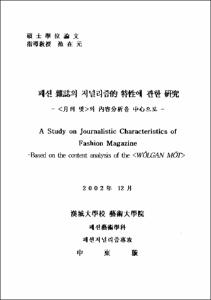패션 雜誌의 저널리즘的 特性에 관한 硏究
= (A) Study on Journalistic Charateristics of Fashion Magazine : Based on the content analysis of the
- Type
- Thesis
- Alternative Title
- <月刊 멋>의 內容分析을 中心으로
- Department
- 패션예술학과패션저널리즘전공
- Issued Date
- 2002
- Publisher
- 漢城大學校 藝術大學院
- Files in This Item:
-
-
Download
 000000066244.pdf
기타 데이터 / 5.44 MB / Adobe PDF
000000066244.pdf
기타 데이터 / 5.44 MB / Adobe PDF
-
Items in Repository are protected by copyright, with all rights reserved, unless otherwise indicated.